by Rusty Fleischer, Program Director –
 When I checked out the word “need”, the Free Online Merriam-Webster Dictionary defined it as:
When I checked out the word “need”, the Free Online Merriam-Webster Dictionary defined it as:
- A situation in which someone or something must do or have something
- Something that a person must have: something that is needed in order to live or succeed or be happy.
The Anger Alternatives’ definition, though shorter and simpler, lines up with that: “Something you must have. You are not OK without it.“ That “not OK” usually turns into feelings of anger, frustration, resentment and more.
Some of you may be familiar with Maslow’s Hierarchy of Needs, developed during the 60’s and 70’s by Abraham Maslow, an American psychologist. The hierarchy is illustrated as a pyramid beginning with basic needs, biological and physiological needs such as air, food, drink, shelter, warmth, sex and sleep. The second level, safety, includes protection from elements, security, order, law, limits and stability. The third level relates to social needs which translate to love and belonging. The fourth level is esteem needs which include self-esteem, achievement and independence. At the top of the hierarchy is self-actualization need, realizing personal potential, self-fulfillment and personal growth.
Because they are needs, whatever need is not satisfied becomes a personal loss and affects the quality of life. All the levels on Maslow’s hierarchy need to be achieved in their respective order, contingent on the lower levels. i.e. if I am operating on a survival level, food and safety will be a priority.
In our teachings, “needs” are fulfilled by “wants”. That may sound odd, so let me give you an example or two to demonstrate what I mean. I am hungry. My “need” is to eat, to satisfy the hunger. What “want” will I use to fulfill that need to eat? I could open a can of tuna and make a tasty tuna salad, I could order-in pizza or I could drive into town and eat at a local restaurant. What I choose is the “want” to fulfill my need to eat. Does that make sense?
Here is another example. I “need” to get from my house to my office which is two miles away. How will I fulfill that need? I could walk, I could drive my car or I could ride my bike. The problem is that it is raining outside and walking or riding my bike are not good ideas and my car is at the repair shop, so that is out also. Fortunately there are other “wants” that fulfill my “need” to get to the office. I could take the bus, call for a cab or even ask my co-worker to give me a ride.
That says a lot about “wants”, they are choices and having choices is empowering.
The two examples I presented were about everyday situations we all encounter in one form or another. It is the same in interpersonal relationships. It is important to first identify what my “need” is. In a relationship it will probably be connected to what Maslow calls level two, safety needs (emotional and physical) and level three, social needs (love and belonging).
In a relationship, it is my responsibility, not the other person’s, to fulfill my needs.
I do this with my “wants”, my choices. The want to fulfill the need is also my responsibility and my choice. It is important to realize and accept that I may not always get what I want and may have to choose something or maybe even someone else. It is also important to be aware that there is always the option of another “want”/choice. I may not be able to see it without support or help from a friend, family member or professional, but it is there.
Another good thing about wants is that they are negotiable. In other words, if I don’t get exactly what I want, I can still be OK with some variation of it by taking into account and consideration of the “wants” of others involved.
So now do you know the difference between a “need” and a “want”?
Can you share an experience?
For more information on the topic of “needs and wants” please contact us.


Speak Your Mind